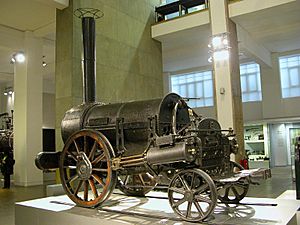Transport during the British Industrial Revolution facts for kids
Before the Industrial Revolution, moving goods around was a big challenge. It cost a lot to transport things like coal or finished products over land using roads. This was okay for light, valuable items like textiles (cloth), but for heavy materials, it made it hard for factories to operate.
However, moving goods by water, on rivers or along the coast, was much cheaper! The first big change came with canals. These were like man-made rivers, often built directly from mines to cities. A famous example is the Bridgewater Canal in Manchester. Tramways, which were special tracks for wagons pulled by horses, were also common.
River Highways
Some rivers, like the Thames, Severn, and Trent, were naturally easy to travel on, especially closer to the sea.
During the 1600s and early 1700s, people improved other rivers. This helped towns like Manchester, Wigan, Hereford, and Newbury in England get their goods to the coast. But these river routes didn't connect the whole country. Canals were the ones that truly linked up the transport network across England. This new way of moving things changed how people saw the world and connected different places.
Toll Roads: The Turnpike Trusts
In England, local people were supposed to fix their roads for free, six days a year. But this wasn't enough for busy roads. So, starting in the 1700s, groups called turnpike trusts were formed. These groups could borrow money to fix and improve roads. They paid back the loans by collecting tolls (fees) from people who used the roads.
In the 1750s, many new turnpike trusts started. By the end of the 1700s, most main roads were turnpike roads. Each trust needed a special law from Parliament to start and to continue operating.
The Rise of Railways

Early railways used horses to pull wagons. Often, the tracks sloped downhill, so horses weren't even needed to pull the wagons down! Instead, brakes were used to slow them. At the bottom, the goods were loaded onto river boats. Then, the horse would pull the empty wagon back up to the mine.
In 1804, Richard Trevithick tried using a steam engine to pull wagons on the Merthyr Tramroad. But it didn't work well because the engine was too heavy for the tracks. It wasn't until the 1820s, when stronger rails made of wrought iron were developed, that steam engines could pull trains over long distances.
These new railways were called edge railways. This meant the wheels of the engine and wagons had a special edge, or flange, that kept them on the tracks. After this, famous railways like the Stockton and Darlington Railway and the Liverpool and Manchester Railway were built. Railways made it much easier for people to travel to factories and jobs.
- In 1829, George Stephenson and Robert Stephenson built a famous steam locomotive called “the rocket.”
See also

